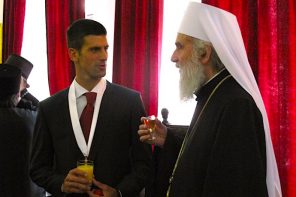While Coronavirus Czar Mike Pence prays away the plague and the CDC offers its lackluster pandemic response, there’s a missing link in the COVID-19 conversation: there’s ultimately no if in dying.
Amid breaking news conveying the intricacies of epidemiology, public health policy, and economic implications to Americans hoarding Lysol wipes, the reality of human fragility is on mute. There have been few attempts to grapple with America’s belief in its own invincibility. Author and RD contributor J. Dana Trent wants to change that. Though we’d rather die than talk about dying she invites us to consider a necessary conversation on human fragility—right now.

Dessert First: Preparing for Death While Savoring Life
J. Dana Trent
Chalice Press
2019
Pandemic or not, the death rate is still 100 percent. None of us is getting out of here alive, and yet only one-third of us have an end-of-life care plan in place. My perspective on talking about that changed after graduating from Duke Divinity School, when I completed a post-graduate residency year in hospital clinical pastoral education (aka chaplaincy) with an unintended specialization in end-of-life care. I stumbled into death, dying, and grief; several months later, my supervisor wrote that I’d taken to end-of-life care chaplaincy “as a morning glory takes to sunlight.” Caring for people in crisis—which even a peaceful, predicted death can be—is comfortable for me.
During those twelve months, I had the honor of sitting bedside with over 200 dying patients of all ages, races, socio-economic backgrounds, and theologies (or those who didn’t have one). They and their families generously shared a collective wisdom about death—and life—which it seemed a disservice not to honor.
What’s the most important take-home message for readers at this cultural moment?
Death is humanity’s great equalizer. It’s the one, single universal thread that unites us. And yet, we find it impossible to talk about—even when the specter of death arrives on a global scale like what we’re experiencing with the Coronavirus. Across all religious, spiritual, indigenous, moral, ethical, and scientific inquiry—humans have, traditionally, attempted to understand and assign meaning to their unavoidable death.
But in the age of technology we believe ourselves to be invincible. Viral outbreak or not, many of our greatest thinkers are urging us to consider the incoming “Silver Tsunami”—the aging of what is historically America’s largest generation—the Baby Boomers, born 1946-1965. Each U.S. Boomer will be 65 or older by 2030. This means that 65 million people face urgent questions about planning for things like aging-in-place and advance directives, as they’re also grieving their own parents. More airtime is being offered to these conversations in the public square, as is evident in the New York Times’ ‘Death and Dying’ series with Dr. George Yancy. But even in the face of pandemic, we still search only for cures in lieu of meaning.
Is there anything you had to leave out?
It was clear to my editor that the earliest manuscript draft was actually three books: a personal narrative of a daughter’s grief; a chaplaincy memoir of an interfaith minister; and an in-depth systematic theology of death and afterlife from the world’s global religious traditions (Hinduism, Buddhism, Judaism, Christianity, and Islam). In the end, books one and two were woven together and the academic study became reader resources to not interrupt the arc. We just couldn’t do justice to the third strand in this volume and there’s a great deal of literature available on that topic in any case. I highly recommend Dr. Christopher M. Moreman’s Beyond the Threshold: Afterlife Beliefs and Experiences in World Religions.
What are some of the biggest misconceptions about your topic?
That we don’t want to discuss death. We actually do—we just don’t have the tools to do it. What is true is that we’re curious about death in different ways—academically, scientifically, existentially, religiously, philosophically, psychologically, spiritually, and practically. We crave intellectual and emotional space to make sense of our own death and the death of others—even if at arm’s length, but it’s unpopular airtime. From grief narratives of tornados, illness, and violence, American culture seeks to make meaning out of suffering and death—the issue is making room to name that. But we’re quick to move on, to fix, to problem solve—to the exclusion of recognizing (and talking about) our fragility.
Did you have a specific audience in mind when writing?
Initially, my ideal readers were Baby Boomers surfing the “Silver Tsunami” for whom Dessert First serves a very practical and emotional need. Many have experienced or are experiencing their parents’ deaths. I wanted to help them address their losses and invite them into conversation starters of practical, legal, and religious/spiritual questions regarding their own preparation for death—all while savoring a sweet life.
What’s fascinating is that now the book has found its feet among college students (Generation Z, ages 16 to mid-20s). They’re curious how Dessert First translates to their experience and what the world’s traditions have to say about death and the afterlife. The book’s content has woven its way into my classroom, not as part of any curriculum, but out of students’ unprompted curiosity. Dessert First morsels help younger people process the kinds of death that surround them: friends’ suicides and overdoses, gun violence, police brutality, parents dying of cancer, and a planet on life support. They notice the macro, micro, and meta expressions of death in their lives: from the current and future effects of climate change, to loss of loved ones, to—in some cases—their own suicide attempts.
The unfurling of COVID-19 narratives have taught us that death is a conversation that applies to all of us. The question is, who will be courageous enough to name that?
Are you hoping to just inform readers? Entertain them? Piss them off?
Dessert First is a sweet toolkit. I’ve faced the complicated deaths of two less-than-perfect parents. I’ve served families who’ve mourned a loved one who’d been a source of tremendous pain and happiness. In grief, gratitude and anger are not mutually exclusive. Embracing death’s complexity with a bit of gentleness gives the reader an access point to process a loss without leaving them rudderless.
What alternative title would you give the book?
Its initial title was Born Dying, which I loved—but Chalice Press felt it was too heavy coming out of the gate. They were right. Once I caught on that it needed a lighter touch, tongue-in-cheek favorites became Grave Matters, Exit Strategy, and Dead on Arrival. The beauty of being the author is that you can recycle abandoned titles as section headers.
How do you feel about the cover?
How does one design a book cover that is invitational and conveys the reality of humanity’s common demise? I love macabre skull art from various traditions, so we played with a calavera-shaped dessert, but that seemed overkill (pun intended). We opted instead for the confetti heart—which symbolizes both the sweetness of relationships amid the bitterness of their shape-shifting fragility. It also represents the complex, moving parts of grief: how do we mourn when the circumstances feel unexpected and awful, like pandemics and tornadoes?
Is there a book out there you wish you had written? Which one? Why?
There are many—The Year of Magical Thinking, The Art of Dying Well, but I couldn’t have, because these are not my personal narratives. The strength of the “death book” genre is each author’s inciting incident. What made each of them write about this? The book I’d love to see next is the privilege of grief. I’m more aware now than ever how I, as a white, cisgender, hetero woman, have been granted this space to process and write about my own grief. How do we pass the mic to communities who want to give voice to their stories?
What’s your next book?
Breaking Good (insert clever subtitle here) is a research-based memoir on systemic issues of drug addiction, mental illness, and poverty in rural Indiana. As the daughter of two failed drug traffickers grappling with mental illness, I learned love in a carnival of chaos. Breaking Good is the behind-the-scenes story of the virtues of this drug-fueled upbringing and the spirituality of survival.
Is there anything else you’d like readers to know about your book?
Just that I am not a happy-clappy, Jesus-loving, God-talker. To be clear, I am rooted in Christianity and authentic Gospel ethos, but Dessert First takes a broader swing. The strength of chaplaincy training is its multi-faith (or no-faith) context. The gift of working with young people in a world religions classroom is a healthy skepticism of any institution, person, or doctrine that says there’s just “one” way to live—or die.





